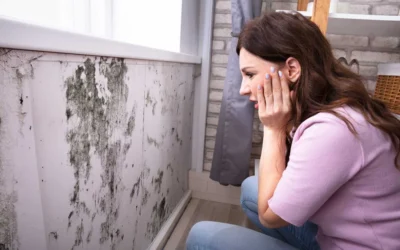Mold is a common indoor environmental hazard that can cause concern for everyone from renters and apartment landlords, to homeowners. If you own a property that someone else rents, it’s important to be aware of local apartment mold laws to protect yourself against the multi-million dollar lawsuits landlords throughout the country are facing for failing to protect tenants against significant mold-related health problems, such as nausea, asthma, chronic fatigue, and more.
Where does mold grow?
There are a variety of mold types that range in color, shape, and growth pattern. Those with the biggest negative impacts on human and pet health include stachybortys, aspergilus, penicillium, paeciloymces, and fusarium. Most of these are black, white, gray, or green in color and have a distinctive smell.
In order to grow, mold needs moisture, nutrients, and habitable temperatures. You’ll most often find mold growth underneath leaking piping and on water-soaked materials like ceiling tiles, wall paneling, and fabric. Buildings in humid climates like Texas and the southeastern states generally experience more frequent mold problems than those buildings found in drier, more northern areas.
How can mold affect my health?
There is a lot of debate within the scientific and medical communities about what types of mold, and in which type of situation, mold can pose significant health risks to people living within their vicinity. However, in the real world, there isn’t a lot of debate for those people who actually live amongst mold and can physically feel the consequences of inhaling mold spores.
Of course, not all mold produces the type of mold spores that can impact people and pets. For instance, mold that grows on shower tiles, while not pleasant to look at, won’t pose a risk to human health. However, because it takes an expert to determine which mold is harmful and which mold is merely annoying, it’s highly advisable to contact an expert for a professional diagnosis if you have mold growth.
Are there any apartment mold laws?
While there are no federal laws that set permissible exposure limits or building tolerance standards, there are a few states and cities that have enacted mold laws.
California was the first state to enact these types of apartment mold laws with the passing of the Toxic Mold Protection Act of 2001. This law authorizes the state’s Department of Health Care Services to establish permissible levels of interior mold exposure for those who might be sensitive to the health repercussions, this includes children and people with respiratory sensitivities. This law requires landlords to disclose to both current and prospective tenants the presence of any known and/or suspected mold growth.
The city of San Francisco went a step further to categorize mold growth as a legal nuisance in the same category as vermin infestations. A tenant or health inspector who notices mold growth can enact the city’s apartment mold laws to sue landlords for failure to disclose information about mold growth and failure to clean up problem areas.
What is a landlord’s duty in regards to mold growth?
If you rent and you suspect that mold growth is caused by your landlord’s failure to fix leaks, even if you don’t live in California, there are things you can do. In every state but Arkansas, landlords are obligated to keep housing maintained, including taking care of leaking pipes, windows, and roofs that are a common cause of mold growth.
If you own property that is being rented and suspect mold is caused by negligent tenant behavior, such as a failure to maintain cleanliness, you are not liable for the health impacts of mold on your tenants.
Hey Property Managers! Download a free copy of our Don’t Get Sued! eBook to learn how to mitigate the liability risks associated with asbestos, lead paint, and mold.



